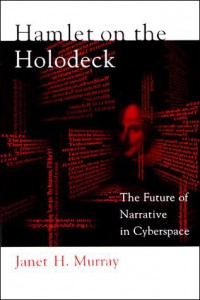Janet Murray
We live at an extraordinary time in human history when a new medium of representation has come into our hands. This has happened before—most spectacularly in the unrecorded moment when our early human ancestors invented spoken language, and again with the invention of drawing, writing, printing, photography, and the diverse electronic recording and transmitting media of the past two centuries: the telegraph, telephone, movies, radio, and television. The computer, like all of these media, is a means of focusing shared attention by establishing conventions for capturing information in a commonly shared code and moving it across time and space. And like earlier media, it is transformative because of its augmentation of our powers to share our thoughts and coordinate our behaviors.
As a humanist trained in the history of the novel, I was drawn to the then nameless profession of interaction design when I was teaching at MIT in the early 1980s and my students showed me the first interactive narrative artifacts ever made—a text-based conversation named Eliza that responded like a therapist by echoing keywords taken from the user’s input (“Tell me more about your mother.”) and a text-based adventure game called Zork that put the player in a navigable maze with trolls and treasures (“A passage leads to the west and a dark staircase can be seen leading upward”). I had learned programming working for IBM between college and graduate school and so I understood how these interactive stories could be made of computer code. I realized from studying the development of the English novel that expressive new conventions of storytelling could grow over time within a tradition of practice. It was exciting to me that my students and I could help to build this tradition of practice by making narratives out of code. And as a humanist I also wanted to describe the tradition, to write books and articles about it as well as to make artifacts. Since the 1980s, I have seen both practices grow and cross-fertilize one another: the design work of inventing new expressive and informational digital genres, and the analytical work of describing these new artifacts as part of larger cultural practices.
The boundary between videogames and stories has proven to be a particularly fertile expanse, with many kinds of practitioners, some more literary and text-based, some more cinematic, some more mainstream and formulaic, some more independent and idiosyncratic. Humanistic discourse has had to expand just as it did with the advent of film to consider games as complex cultural forms worthy of analysis. Designers have welcomed this discourse as a source of vocabulary for describing what they do, helping them to articulate their aesthetics, and to identify ways to do it better.
Storytelling is one of the oldest human activities, a means of sharing our understanding of the world, creating cultural affiliations and identities, testing our moral judgments, and expanding our capacity for empathy.
Faculty and students in Digital Media at Georgia Tech occupy a privileged position as both theorists and practitioners of digital design. As humanistic designers, we are driven not by the novelty of the technology, but the unexplored possibilities for making meaning. For me, the most enticing possibilities lie in the structures we can create for more complex storytelling. Television is a particularly rich source of narrative design problems. Digital transmission has opened up the possibility of long-form storytelling, since audiences can view whole seasons after their original broadcast date, and they can follow story over multiple seasons. This is leading to greater consistency and ambition in storytelling, but it is also confusing to audiences, which opens up productive opportunities for interaction design.
Why create aids for watching TV shows? Storytelling is one of the oldest human activities, a means of sharing our understanding of the world, creating cultural affiliations and identities, testing our moral judgments, and expanding our capacity for empathy. Structures that help us to tell and to receive more complex stories hold the promise of expanding human potential. Of course, that potential can be used for constructive or destructive purposes. For me, as a child of the enlightenment with a faith in human reason and the democratization of knowledge, and as an educator within the problem-solving atmosphere of an Institute of Technology, I lean to the optimistic view.
The answer to “what will become of us in the digital age if newspapers or books or television networks suddenly disappear?” is to identify the longer history of the activity, to retrace how it took the shape it currently has, and to try to see what value it has independent of particular media objects.
Working in a field that has brought such radical change to social practices and revenue streams, I have often been confronted by panicking professionals including print journalists, broadcast news producers, heads of movie studies, publishers, librarians, Shakespeare scholars, and deans of universities, all of whom have good reason to worry about how changes in the inscription and transmission and information will affect their job security and the future of their institutions. My response to this very real anxiety is always the same: Consider the core function of what you are doing and focus on preserving and expanding that, rather than fetishizing the current media formats. This is also the first step in the radically constructive design process that I teach my students in the core course in interaction design. It comes from the humanistic stance of stepping back from the current moment and to look at the situation within the longer view of human culture. The answer to “what will become of us in the digital age if newspapers or books or television networks suddenly disappear?” is to identify the longer history of the activity, to retrace how it took the shape it currently has, and to try to see what value it has independent of particular media objects. A newspaper or TV news show is valuable because professional journalism is valuable with or without the current methods of segmenting and transmitting it. The question is not how do we preserve legacy formats, but how do we expand the journalistic enterprise by harnessing the powerful expressive affordances of the digital medium?
As an educator in a rapidly changing field I have a responsibility to train students with methods that will last them over their career. Humanistic design methods offer the best framework for that approach, in my view, by providing us with a radical perspective that can turn the threat of digital disruption into the opportunity for creative invention and renewal.


